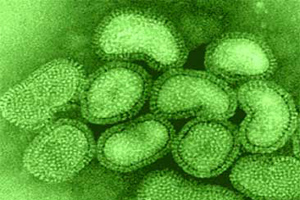Report compares old and new European AI outbreaks

Since the beginning of November 2014, nine outbreaks of highly pathogenic avian influenza virus (HPAIV) A(H5N8) in poultry have been detected in four European countries. In a report published by Eurosurveillance, the similarities and differences between the modes of introduction of HPAIV A(H5N1) and A(H5N8) into Europe are examined.
In autumn 2005, Romania and Croatia were the first European countries reporting influenza A(H5N1) virus infections in wild birds and domestic poultry; hereafter, it spread rapidly across central Europe starting in February 2006. When HPAIV A(H5N1) finally disappeared in 2010, it had been detected in wild birds and poultry in 21 European countries. Prior to the introduction into Europe, HPAIV A(H5N1) was extensively circulating in poultry, with recurrent spill-overs to wild birds, in Asia.
Influenza A(H5N8) virus is a complex reassortant virus carrying genes from A(H5N1) as one of its parental viruses. An ancestral strain was first reported in China in 2010. In 2014, following further virus evolution via reassortment, several outbreaks with HPAIV A(H5N8) viruses occurred in aquatic migratory birds, chickens, geese and ducks in China, Japan, and Republic of Korea. Between 5 November and 16 December 2014, Germany, Italy, the Netherlands, and the United Kingdom (UK) reported HPAIV A(H5N8) outbreaks in nine holdings in total, with turkeys, chickens or ducks.
In November and December 2014, HPAIV A(H5N8) was detected in a healthy common teal (Anas crecca) in Germany and in two faecal samples from Eurasian wigeons (Anas penelope) in the Netherlands. The region in Germany currently affected by HPAIV A(H5N8) largely matches the area that was first affected by HPAIV A(H5N1), whereas in the UK, cases of A(H5N1) were initially located in eastern and southern regions and in Italy in central and southern regions, but not in the areas affected in November 2014. The Netherlands had not been affected by HPAIV A(H5N1) at all.
Influenza A(H5N8) virus infection does not appear to be associated with severe illness or excessive mortality in wild mallard ducks. In contrast, in galliform poultry (turkey, chickens), HPAIV A(H5N8) causes mass mortality as seen in affected holdings. The low to moderate virulence of HPAIV A(H5N8) in domestic ducks seen in the UK resembles the situation in wild mallards. Many strains of HPAIV A(H5N1), in contrast, cause high mortality not only in galliformes but also in anseriform poultry and in wild birds.
Routes of introduction into Europe
The spread of HPAIV A(H5N1) from east Asia to Europe via central Asia may have occurred by a complex mixture of activities associated with poultry production, illegal poultry transports, spill-over infections to wild birds, and migratory bird dispersal, but no consistent route of infection into poultry holdings within Europe has been identified. The sudden occurrence of HPAIV A(H5N1) in central Europe in 2006 was probably associated with cold spells in western Russia that drove out substantial numbers of putatively infected wild birds further west.
Mutual transmission of HPAIV between migratory birds and domestic poultry might occur through direct or indirect contacts. Genetic analyses of the recent European influenza A(H5N8) viruses revealed very high similarity to Japanese wild bird isolates suggesting a common source of infection.
Import of live poultry and live captive birds as well as poultry commodities from affected Asian regions to the European Union (EU) is illegal but cannot be formally excluded as route of introduction for HPAIV A(H5N8); however, this seems unlikely considering the simultaneous nature and geographic spread of the outbreaks. No epidemiological links have been identified between the initially affected holdings in Germany, the Netherlands and the UK. Findings of HPAIV A(H5N8) in wild birds in Europe also open a possibility for an importation from Asia to Europe via migratory wild birds although this remains hypothetical until the virus would be found in further wild bird populations in central and western Asia.
Affected holdings in Europe so far were indoor facilities with nominally good biosecurity, yet indirect contact between wild birds and poultry (via any material contaminated by infected wild birds, e.g. faeces) might be possible. The fact that in several of the holdings, stable units closest to the entrance of the compound were the first affected in the outbreak, might suggest the introduction of A(H5N8) from a focal source close to the compound.
Surveillance of highly pathogenic avian influenza viruses
The experience of large HPAIV outbreaks of in the Netherlands, Belgium and Germany, e.g. A(H7N7) in 2003, prompted the EU to better prepare for large scale incursions of HPAIV. The establishment and implementation of surveillance systems, diagnostic tools for early detection of HPAIV and harmonised restriction and control measures was laid down in the EU legislation. This included introducing programmes of passive surveillance of wild bird populations as an early warning system, which proved to be a useful tool in detecting presence of HPAIV A(H5N1). This was complemented by active monitoring of poultry. In the current epizootic, enhanced wild bird monitoring might also help to further elucidate the role of wild birds transmitting A(H5N8), although the apparently asymptomatic presentation in wild bird species in Europe indicates potentially scaling up elements of targeted active rather than passive surveillance may be appropriate to better understand the distribution, prevalence and introduction pathways into Europe.
Conclusions
The current simultaneous occurrence of A(H5N8) in different European countries is comparable to the introduction of A(H5N1) around a decade ago. These similarities may point to common routes of introduction into Europe, although these are not fully understood and the exact sources of infection of the affected indoor poultry holdings have not been identified yet.
Based on the experience from HPAIV A(H5N1) in Europe, efficient biosecurity, early detection, and stringent control measures are able to minimize risks of spill-over transmission to humans. The rapid geographic dispersion of yet another reassortant highly pathogenic avian influenza A virus underlines the need for enhanced preparedness.
To view the report in full click here.












